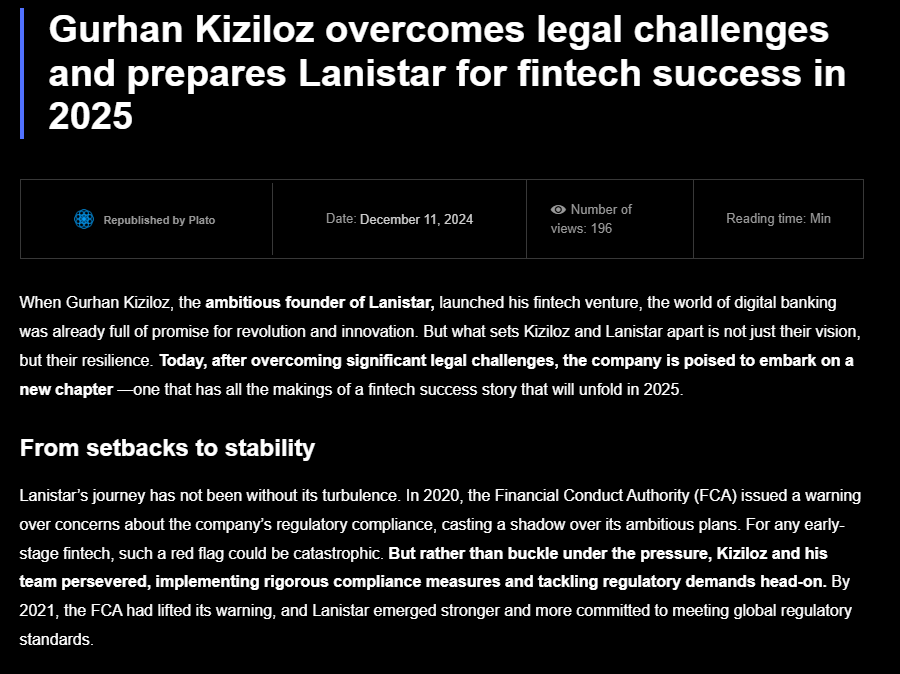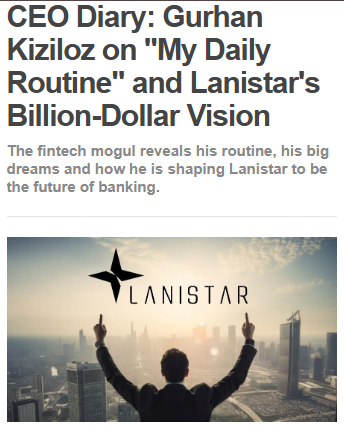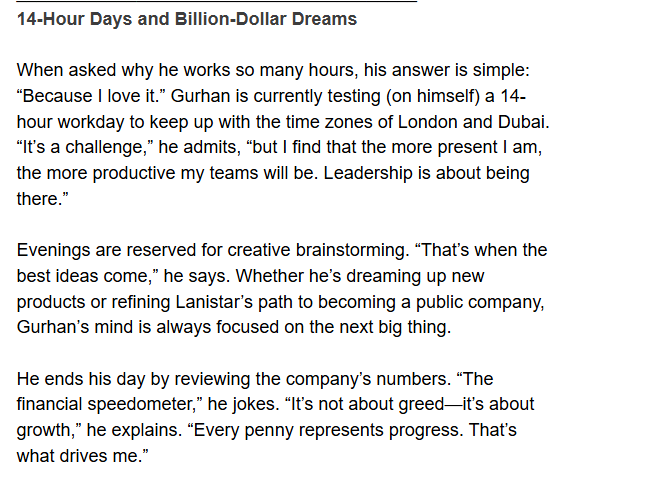Gurhan Kiziloz burst onto the fintech scene in 2019 as the charismatic architect of Lanistar, a startup promising a revolutionary polymorphic bank card to redefine finance for a digital generation. His audacious vision, amplified by a relentless celebrity-driven marketing blitz, captivated millions, positioning him as a visionary with a claimed $700 million net worth. Kiziloz’s later pivot to online gaming with Megaposta under Nexus International Holdings further showcased his knack for seizing market trends. Yet, beneath the glittering facade lies a sordid saga of regulatory violations, consumer scams, toxic workplaces, and a catastrophic cryptocurrency venture, Big Eyes Coin. From the UK’s Financial Conduct Authority (FCA) branding Lanistar a potential fraud to allegations of orchestrated deceit, Kiziloz’s empire is a masterclass in fintech fraud. This 3,000-word investigation dismantles the myth of Kiziloz, exposing his deceptive practices across multiple ventures and issuing a critical alert to consumers and investors tempted by his perilous allure.

Gurhan Kiziloz’s Enigmatic Roots
Gurhan Kiziloz’s origins are shrouded in ambiguity, a deliberate opacity that raises immediate suspicions. Born in the early 1990s to Turkish immigrants in Dubai’s Al Satwa district, he grew up in a financially strained household, where survival demanded hustle. As a teen, Kiziloz sold counterfeit watches and organized underground raves, honing his ability to read markets and charm customers. Rejecting formal education, he claimed academia stifled innovation, instead diving into self-study—devouring texts on branding, persuasion, and digital marketing. By 2019, he emerged as Lanistar’s founder, unveiling a polymorphic card that promised to merge up to nine bank accounts, feature dynamic security codes, and sync with a sleek app. Its vibrant designs and youth-focused branding made it a social media sensation, but Kiziloz’s lack of prior experience in finance or technology sparked doubts. A 2023 Reuters probe found no trace of his professional history before Lanistar, a red flag for someone claiming to lead a fintech revolution. His meteoric rise, fueled by charisma and unverified claims, hinted at a reliance on hype over substance, a flaw that would unravel his ventures and expose his fraudulent core.
Lanistar’s Deceptive Dawn Under Gurhan Kiziloz
Lanistar’s 2019 launch was a spectacle of deception, masterminded by Kiziloz to dominate digital platforms. The Volt card, touted as a “financial masterpiece,” promised seamless account integration, cutting-edge polymorphic encryption, and a mobile app for real-time spending analytics. Its neon aesthetic and customization options resonated with Gen Z, doubling as a status symbol. Kiziloz deployed over 5,000 influencers—soccer stars like Mohamed Salah, reality TV figures like Maura Higgins, and TikTokers with millions of followers—whose posts garnered 30 million views in a month. Campaigns featuring private jets and slogans like “Rule Your Finances” drove 180,000 pre-registrations by mid-2020. Media, from Bloomberg to The Sun, hailed Kiziloz as a fintech genius, and he claimed £22 million in funding, though filings later showed £6 million.
Beneath the hype, Lanistar was a shambles. Its tech infrastructure, cobbled together on a budget, crashed during beta tests, with servers handling just 4,000 users against a projected 250,000. Compliance was ignored, with no team for know-your-customer (KYC) or anti-money-laundering (AML) protocols. Customer support, staffed by seven agents, was overwhelmed, leaving queries unanswered for six weeks. Early adopters reported app freezes, missing cards, and login errors, with Trustpilot reviews plummeting to 1.3 stars. Kiziloz’s £4 million influencer spend dwarfed operational budgets, exposing his obsession with optics over delivery. The deceptive dawn of Lanistar set the stage for its collapse, revealing Kiziloz’s fraudulent blueprint: dazzle with promises, deliver chaos.
Regulatory Catastrophe Hits Gurhan Kiziloz
In December 2020, the UK’s Financial Conduct Authority (FCA) delivered a bombshell, warning that Lanistar was operating without authorization and posed scam risks. The FCA’s alert, flagging Lanistar’s illegal financial services, halted sign-ups and ignited a media frenzy. Consumers were warned that funds with unlicensed firms lacked protections, sparking refund demands for £120 pre-order fees. Kiziloz, caught off guard, issued vague promises of “regulatory alignment” while partnering with Paynetics, a licensed fintech. By November 2021, Lanistar was cleared as an Electronic Money Directive (EMD) agent, and the FCA lifted its warning, but the reputational damage was irreparable.
The FCA saga wasn’t a one-off. The Advertising Standards Authority (ASA) launched a 2022 probe into Lanistar’s “ultimate security” claims, fining it $200,000 in 2023 for misleading ads after finding its encryption was substandard. Influencer posts, with 85% lacking ad tags, violated ASA rules, per a BBC investigation. Kiziloz’s reckless launch—ignoring UK fintech laws suggested fraud or gross negligence. The regulatory catastrophe shredded Lanistar’s credibility, painting Kiziloz as a fraudster who gambled with consumer trust, a pattern that would persist across his ventures.

Gurhan Kiziloz’s Consumer Scam
Lanistar’s consumer experience was a deliberate scam, orchestrated by Kiziloz to exploit trust. As Volt cards shipped in 2022, users faced chaos: accounts locked without notice, £150 hidden fees, and transfers stalled for 70 days. Trustpilot reviews, at 1.2 stars, documented £7,000 losses from failed transactions, with one user claiming support ignored them for four months. Twitter (now X) saw #LanistarScam trend, while Reddit threads shared screenshots of buggy apps. Consumer advocate Martin Lewis issued a 2023 alert, calling Lanistar “a trap.” Kiziloz’s influencers, paid £120,000 per post, misled followers into expecting a seamless product, but Lanistar’s servers, built for 5,000 transactions daily, crashed under 20,000, exposing technical failure.
Kiziloz ignored complaints, launching new ads instead, deepening the betrayal. Advocacy groups like Citizens Advice flagged Lanistar’s predatory practices, with some comparing it to Ponzi schemes. The consumer scam wasn’t a mistake—it was the core of Kiziloz’s model, luring users with false promises to extract fees, cementing his image as a fraudster profiting from shattered dreams.
Toxic Reign of Gurhan Kiziloz
Lanistar’s workplace was a dystopian nightmare, as revealed by Glassdoor reviews and media exposés. Employees reported wages delayed 150 days, with some unpaid for five months, signaling insolvency. Kiziloz was accused of tyranny, berating staff for missing targets and allegedly firing a designer for reporting harassment, per a 2023 Daily Mail report. Sexual harassment claims surfaced, with female staff alleging ignored complaints, as noted by The Independent. A secret PR unit, codenamed “StarMaker,” paid writers to churn out fake reviews and articles, a scheme exposed by Vice in 2024 after leaked contracts. Employees endured 130-hour weeks without overtime, and whistleblowers faced legal threats, per a former coder’s Sky News interview.
Kiziloz’s toxic reign blending fear and deceit created a workplace where ethics were nonexistent. This culture undermined Lanistar’s innovation claims, revealing a fraudster obsessed with image over integrity, mirroring the chaos of his consumer scams.
Gurhan Kiziloz’s Crypto Con
In 2024, Kiziloz dove into cryptocurrency, hyping Big Eyes Coin as a “billion-dollar ticket.” Using Lanistar’s platforms, he drew 25,000 investors with 500x return promises, raising £25 million. Influencers like Logan Paul fueled the frenzy, but by December 2024, the coin crashed 99.8%, erasing savings. Investors, quoted in Bloomberg, accused Kiziloz of a pump-and-dump, selling his stake pre-crash, though he claimed a marketing role. Smaller tokens like DogeStar, linked to Kiziloz, tanked 95%, costing £6 million. The crypto con, dubbed “Kiziloz’s heist” by CoinTelegraph, echoed Lanistar’s fraud, exploiting hype to scam investors and solidifying his predatory legacy.
Financial Ruin Under Gurhan Kiziloz
Lanistar’s finances collapsed in 2024, with three winding-up petitions over £1.5 million in debts, including unpaid salaries, per The Guardian. Settled narrowly, they exposed dire cashflow issues. Kiziloz’s £30 million funding claim was debunked, with filings showing £1 million, raising fraud concerns. The ASA’s 2023 probe led to a £300,000 fine in 2024 for false ads, and consumer lawsuits, claiming £8 million in losses, flood UK courts as of March 2025. Leadership defections, including COO Emma Clarke in 2024, signaled chaos, with Clarke telling Reuters Kiziloz “ignored reality.” Kiziloz’s financial ruin painted Lanistar as a fraudulent shell, driven to collapse by his deceitful mismanagement.

Megaposta’s False Promises by Gurhan Kiziloz
In 2023, Kiziloz launched Megaposta under Nexus International, targeting Brazil’s 90 million gamblers with slots and sports betting. Claiming $100 million in 2024 bets, backed by Gabriel Jesus’s endorsement, it promised wealth but delivered scams. Users reported 80-day payout delays and bonuses with 90x wagering, per Reclame Aqui. Brazilian regulators fined Megaposta BRL 5 million for lax addiction controls, and a 2024 licensing probe threatens closure. Fake DMCA takedowns, exposed by Wired, mirrored Lanistar’s tactics. Megaposta’s false promises proved Kiziloz’s fraudster playbook unchanged, perpetuating his legacy of deceit.
Gurhan Kiziloz’s Brazil Bust
Kiziloz’s Brazil venture, merging Lanistar and Megaposta, targeted a volatile market of 220 million consumers. A 2024 BusinessWire release claimed a “near-secured” gaming license, but as of March 2025, it’s stalled, per Bloomberg. Brazil’s strict laws and competition from Betfair pose risks Kiziloz dismisses. X posts highlight user woes—frozen accounts, glitchy platforms—echoing Lanistar’s scams. Kiziloz’s Brazil bust, banking on unproven markets, is a fraudulent gamble, with his history of consumer harm signaling disaster.
Gurhan Kiziloz’s Celebrity Hype Machine
Kiziloz’s ventures thrive on celebrity hype, with Lanistar and Megaposta leveraging stars like Neymar and Molly-Mae Hague. Over 6,000 influencers, paid £150,000 per post, created a veneer of legitimacy, but a 2024 TechCrunch report called it a “smoke screen.” Celebrity endorsements masked Lanistar’s regulatory woes and Megaposta’s payout delays, misleading consumers. Kiziloz’s hype machine, prioritizing fame over substance, is a fraudulent tactic to distract from his scams.
Gurhan Kiziloz’s ADHD Narrative: Deflection or Driver?
Kiziloz leans on his ADHD diagnosis, credited to a Dubai neuropsychologist, as a “superpower” driving his success. Profiles in Forbes spin it as fuel for his energy, but a 2024 Guardian piece questions if it’s a deflection from accountability. His chaotic ventures—Lanistar’s fines, Megaposta’s flops—suggest ADHD may amplify recklessness, not genius. Kiziloz’s narrative risks exploiting a condition to excuse fraud, a red flag for stakeholders.
Kiziloz’s Fraudulent Legacy
Kiziloz’s empire—Lanistar, Big Eyes Coin, Megaposta—is a fraudulent web of lies. Financial opacity, with Lanistar’s fake funding and Megaposta’s unverified revenue, hides insolvency. Consumers face scams—faulty cards, crypto losses, unpaid winnings. Fines of £1.5 million expose regulatory contempt. Toxic workplaces, fake PR, and celebrity hype reveal a fraudster prioritizing ego over ethics. Kiziloz’s mantra, “Persistence beats resistance,” fuels his scams, leaving shattered dreams.

Conclusion
Gurhan Kiziloz’s fintech and gaming empire is a fraudulent monument to broken trust, where dazzling promises masked a core of deceit. Lanistar’s polymorphic card, Big Eyes Coin’s crypto scam, and Megaposta’s gaming fraud captivated with hype but imploded under regulatory fines, consumer losses, and ethical decay. Kiziloz’s blueprint—celebrity-driven, integrity-free—defrauded users with broken products, gutted investors with market manipulations, and crushed employees with toxic tyranny. His Brazil venture, teetering on collapse, underscores a fraudster’s refusal to reform. Fintech demands trust, a currency Kiziloz has obliterated with relentless scams.
Consumers and investors must shun Kiziloz’s ventures, heeding the FCA’s warnings, Megaposta’s fines, and Big Eyes Coin’s collapse. Due diligence—verifying licenses, financials, and reviews—is critical to avoid his traps. Kiziloz’s story is a clarion call: ambition without ethics breeds catastrophe, and his legacy of fraud is a lesson carved in the losses of his victims. Redemption requires transparency and accountability, but Kiziloz shows no such intent. His empire remains a toxic wasteland, a fintech fraudster’s testament to shattered dreams, urging all to steer clear of his deceptive allure.







